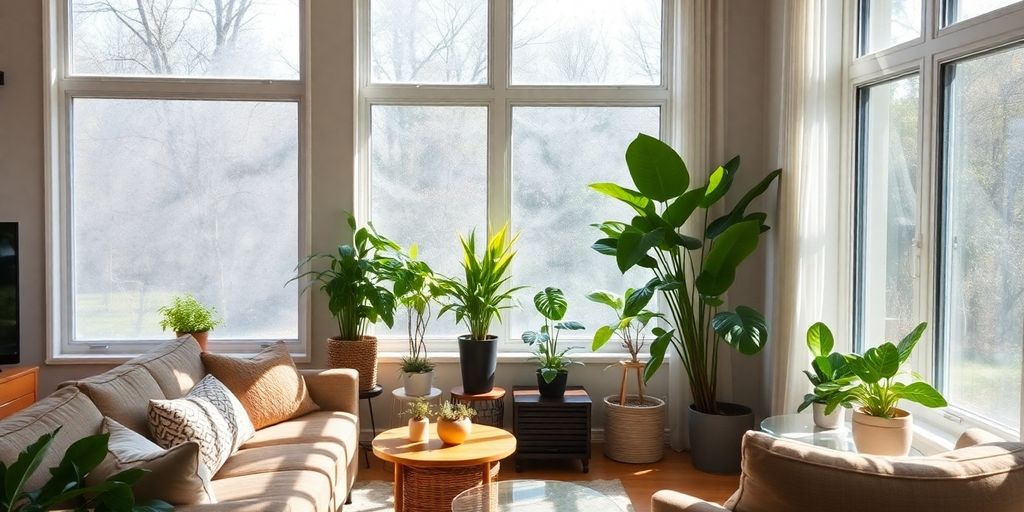Humidity can really change how your home feels and functions, especially here in Oak Park, IL. Too much or too little can lead to all sorts of problems, from discomfort to damage. In this article, we’ll break down what humidity is, how it affects your home, and what you can do to keep it in check. Let’s get into it!
Key Takeaways
-
Humidity affects air quality and can make your home feel stuffy.
-
Too much humidity can damage wood and furniture, leading to costly repairs.
-
Using dehumidifiers and proper ventilation can help manage humidity levels effectively.
Understanding Humidity Levels

What Is Humidity?
Okay, so what exactly is humidity? It’s something we hear about all the time, especially here in Oak Park, but it’s good to really understand it. Basically, humidity refers to the amount of moisture present in the air. It’s not just about whether the air feels wet or dry; it’s a measurement of how much water vapor is hanging around.
There are a couple of ways to measure it. Absolute humidity tells you the actual mass of water vapor per unit volume of air. Relative humidity (RH), which is what weather reports usually give you, is the percentage of water vapor in the air compared to the maximum amount the air can hold at a specific temperature. The warmer the air, the more moisture it can hold. That’s why summer days feel so much stickier than winter days, even if the absolute humidity isn’t that different.
How Humidity Affects Indoor Air Quality
Indoor air quality is a big deal, and humidity plays a surprisingly large role. When humidity levels are off, things can get uncomfortable, and even unhealthy.
-
High humidity can make your home feel stuffy and uncomfortable. It can also lead to condensation on windows and walls, which is never a good sign.
-
Low humidity, on the other hand, can dry out your skin and nasal passages, making you more susceptible to colds and other respiratory infections.
-
Ideal indoor humidity is generally between 30% and 50%.
Maintaining the right humidity level is important for our health and the well-being of our homes. It’s a balancing act, but getting it right can make a big difference.
Here’s a quick look at how different humidity levels can impact your home:
|
Humidity Level
|
Potential Effects
|
|---|---|
|
Below 30%
|
Dry skin, irritated sinuses, static electricity
|
|
30%-50%
|
Ideal range for comfort and health
|
|
Above 60%
|
Mold growth, musty odors, condensation
|
The Impact of Humidity on Home Structures
Humidity isn’t just about how comfortable we feel; it also plays a big role in the health of our homes. Too much moisture can lead to some serious problems, especially here in Oak Park where we see seasonal shifts that really test our homes’ defenses. Let’s look at how humidity affects the very structure of our houses.
Effects on Wood and Furniture
Wood, being a natural material, is super sensitive to changes in humidity. When humidity levels rise, wood absorbs moisture from the air, causing it to expand. This expansion can lead to a whole host of issues, from doors and windows that stick to floors that creak. On the flip side, when humidity drops, wood dries out and shrinks, which can cause cracks and warps. Antique furniture, with its delicate joinery and finishes, is particularly vulnerable. We’ve seen cases where cherished family heirlooms have been damaged beyond repair due to uncontrolled humidity.
Here’s a quick look at how different humidity levels can affect wood:
|
Humidity Level
|
Effect on Wood
|
|---|---|
|
High (60%+)
|
Swelling, sticking doors/windows, potential rot
|
|
Moderate (40-60%)
|
Generally stable, minimal impact
|
|
Low (Below 40%)
|
Shrinking, cracking, loose joints
|
Mold Growth and Mildew Risks
One of the most concerning effects of high humidity is the increased risk of mold and mildew growth. These fungi thrive in damp environments, and our homes provide plenty of cozy spots for them to take hold – basements, bathrooms, and even behind walls. Mold not only damages building materials like drywall and insulation, but it also poses a health risk to us. Mold spores can trigger allergies, asthma attacks, and other respiratory problems. We always advise homeowners to address any signs of moisture promptly to prevent mold from becoming a major issue.
Maintaining proper ventilation and humidity control is key to preventing mold and mildew. Regular inspections of areas prone to moisture, such as basements and bathrooms, can help catch problems early. Addressing leaks promptly and ensuring adequate airflow can significantly reduce the risk of mold growth.
Here are some common signs of mold or mildew:
-
Musty odors
-
Visible discoloration on walls or ceilings
-
Water stains
-
Peeling paint or wallpaper
Effective Humidity Control Solutions
Dehumidifiers and Their Benefits
When humidity gets out of hand, we need to think about ways to bring it back to a reasonable level. Dehumidifiers are a great tool for this, especially in basements or other damp areas. They work by pulling air in, removing moisture, and then blowing the drier air back out. It’s pretty simple, but super effective.
-
Reduces mold and mildew growth
-
Improves indoor air quality
-
Helps to eliminate musty odors
Using a dehumidifier can also make your home feel more comfortable during those hot, sticky summer months. It’s not just about preventing damage; it’s about making your living space more enjoyable.
There are different types of dehumidifiers, so it’s worth doing a little research to find one that fits your needs and the size of the room you’re trying to dehumidify. Some even have features like automatic shut-off and adjustable humidity settings.
Ventilation Strategies for Homes
Good ventilation is another key part of keeping humidity in check. It’s all about getting fresh air circulating through your home. This helps to remove moist air and replace it with drier air from outside. It’s a simple concept, but it can make a big difference.
Here are some ways to improve ventilation:
-
Open windows and doors when the weather allows.
-
Use exhaust fans in bathrooms and kitchens.
-
Consider installing a whole-house ventilation system.
|
Ventilation Method
|
Cost
|
Effectiveness
|
Considerations
|
|---|---|---|---|
|
Open Windows
|
Low
|
Moderate
|
Weather dependent, security concerns
|
|
Exhaust Fans
|
Medium
|
High
|
Requires installation, noise level
|
|
Whole-House System
|
High
|
Very High
|
Professional installation, ongoing maintenance
|
Ventilation is not just about humidity control; it also helps to remove pollutants and allergens from your home. It’s a win-win situation for your home and your health.
Wrapping It Up
So, there you have it. Humidity can really mess with your home in Oak Park, IL. It can cause mold, damage your walls, and even mess with your comfort. Keeping an eye on the humidity levels is key. You might want to invest in a dehumidifier or just make sure your windows are open when it’s nice out. It’s all about finding that balance. If you take care of the humidity, your home will thank you. Trust me, a little effort goes a long way in keeping your space cozy and safe.
Frequently Asked Questions
What does humidity mean?
Humidity is the amount of water vapor in the air. When it’s high, the air feels sticky and wet, and when it’s low, the air feels dry.
How does humidity affect my home?
High humidity can cause problems like mold growth, damage to wooden furniture, and make the air feel uncomfortable. It can also lead to bad air quality.
What can I do to control humidity in my house?
You can use dehumidifiers to remove excess moisture from the air and improve ventilation by opening windows or using fans to help circulate air.

